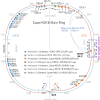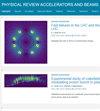Collimator challenges at SuperKEKB and their countermeasures using nonlinear collimator
IF 1.8
3区 物理与天体物理
Q3 PHYSICS, NUCLEAR
Physical Review Accelerators and Beams
Pub Date : 2024-08-14
DOI:10.1103/physrevaccelbeams.27.081001
引用次数: 0
Abstract
In SuperKEKB, movable collimators reduce the beam background noise in the Belle II particle detector and protect crucial machine components, such as final focusing superconducting quadrupole magnets (QCS), from abnormal beam losses. The challenges related to the collimator, which were not properly considered at the time of SuperKEKB design, have surfaced through experience with its operation. In this paper, we report the collimator operation strategy in SuperKEKB. In addition, a significant challenge of beam collimation due to the future increase in the beam background is highlighted. We also discuss another issue caused by unexpected and sudden beam losses in the machine that damage collimators, leading to weaker beam collimation performance and an increase in transverse impedance. Furthermore, we introduce a novel collimation approach called the nonlinear collimator (NLC) to address these challenges. We detail the concept of NLC and evaluate their effectiveness by assessing the collimator impedance, beam background reduction, and impact on the dynamic aperture. The possibility of using NLCs as absorber collimators to counteract events that damage the collimator is also shown to be helpful.

超级 KEKB 的准直器难题及其使用非线性准直器的对策
在超级 KEKB 中,可移动准直器可降低 Belle II 粒子探测器中的光束背景噪声,并保护最终聚焦超导四极磁体(QCS)等关键机器部件免受异常光束损失的影响。在设计 SuperKEKB 时没有适当考虑到与准直器有关的挑战,但随着其运行经验的积累,这些挑战逐渐浮出水面。本文报告了 SuperKEKB 中准直器的运行策略。此外,我们还强调了由于未来光束背景增加而带来的光束准直方面的重大挑战。我们还讨论了另一个问题,即机器中意外和突然的光束损失会损坏准直器,导致光束准直性能减弱和横向阻抗增加。此外,我们还介绍了一种名为非线性准直器(NLC)的新型准直方法,以应对这些挑战。我们详细介绍了非线性准直器的概念,并通过评估准直器阻抗、光束背景降低以及对动态孔径的影响来评估其有效性。此外,我们还展示了将非线性准直器用作吸收准直器来抵消损坏准直器的事件的可能性。
本文章由计算机程序翻译,如有差异,请以英文原文为准。
求助全文
约1分钟内获得全文
求助全文
来源期刊

Physical Review Accelerators and Beams
Physics and Astronomy-Surfaces and Interfaces
CiteScore
3.90
自引率
23.50%
发文量
158
审稿时长
23 weeks
期刊介绍:
Physical Review Special Topics - Accelerators and Beams (PRST-AB) is a peer-reviewed, purely electronic journal, distributed without charge to readers and funded by sponsors from national and international laboratories and other partners. The articles are published by the American Physical Society under the terms of the Creative Commons Attribution 3.0 License.
It covers the full range of accelerator science and technology; subsystem and component technologies; beam dynamics; accelerator applications; and design, operation, and improvement of accelerators used in science and industry. This includes accelerators for high-energy and nuclear physics, synchrotron-radiation production, spallation neutron sources, medical therapy, and intense-beam applications.
 求助内容:
求助内容: 应助结果提醒方式:
应助结果提醒方式:


